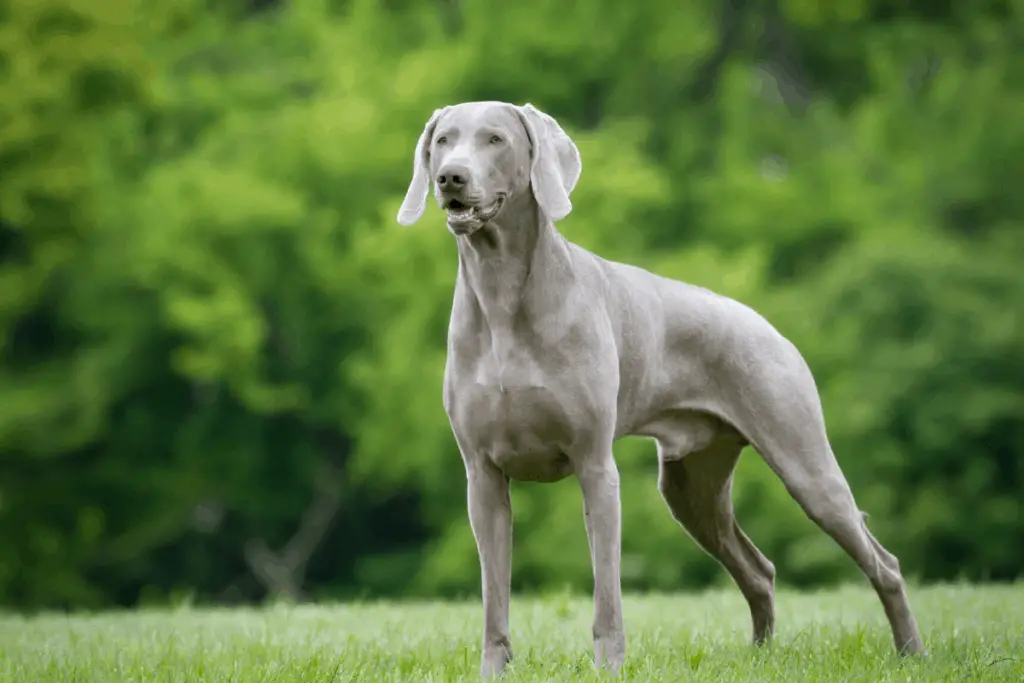
Almost every puppy is born with blue eyes. As many dog breeds grow older, the color of their eyes changes to a darker color.
Those that hold on to their baby blues are treated as rare and special. Blue-eyed dogs are sought out because this feature is so admirable and appealing.
But have you ever thought which hunting dog breed has blue eyes?
What Hunting Dog Breed has Blue Eyes?
The Weimaraner is a great hunting dog breed with blue eyes. It’s true this breed may be a bit underrated. But everyone familiar with it knows that the Weimaraner has the most striking blue eyes of all the hunting dog breeds.
One of the most fascinating features of Weimaraners is the blue shade of their eye changes. The reason for this is as they grow and mature, they produce more melanin, which changes the shade of their eye color, among other features, such as the color of their coat and nose.
When they’re still newborn puppies, their eyes are a light shade of blue. Three months later, their eyes become a deeper shade of turquoise blue. Finally, once they’re a year old, their eye color turns into the beautiful, unique grayish-blue color they’re known and loved for.
The breed was developed in Germany in the early 1800s as pure hunting dogs. They’re known for their great energy and spunk. They have high levels of endurance and courage in the field. Weimaraners are also admired for their high intelligence and commitment.
Some people refer to them as the ‘gray ghost’ because of their refined silver-gray coat. The nickname may also refer to the devotion they show their owners and how they always seem to ‘shadow’ them.
Research shows they’re prone to separation anxiety. They’re sensitive dogs and can be quite demanding at times.

Are Weimaraners Good Hunting Dogs?
The Weimaraner breed became hugely popular with William Wegman’s photographs featuring the breed. This drove up demand and popularity of the breed in non-hunting homes. The focus on breeding for hunting dwindled and the breed as a hunting breed suffered because of that. There are great hunting Weimaraners, but be selective if you are searching for a Weim for hunting and select a reputable breeder that focuses on breeding for hunting.
Weimaraners have a strong personality and can be very willful. They’re extremely confident and fearless dogs. They’re also highly energetic, restless, and active. Add to that list, smart and curious, and you’ve got a top-notch hunting dog. These features make them great companions when you’re out hunting.
The Weimaraner breed is known for its friendly nature. If trained at a young age, their temperament will be one of obedience and a sense of playfulness. Their affectionate nature shows in how they always want to do what their owner is doing. They crave attention and don’t do very well when they’re left alone.
Even though they’re one of the hunting dog breeds, they prefer living indoors. It’s warm and comfy, and it’s where their owners are. Weimaraners’ best living conditions are in a house. It’s also a good idea to provide him with a fenced-in yard where he can safely run and play.
They need about two hours of exercise each day. They love all types of physical activities and mental stimulation. Hunting is an excellent way to get his exercise in for the day. There are other activities you can engage your Weimaraner in, such as hiking, jogging, playing fetch, and other running games.
On average, male Weimaraners can weigh anywhere from 70 to 85 lbs and can reach up to 25 – 27 inches (63.5 – 68.5 cm). Female Weimaraners weigh between 55 – 70 lbs and can be 23 – 25 inches tall.
What Can you Hunt with a Weimaraner?
The Weimaraner is considered a versatile breed. Meaning they can be used to hunt upland, waterfowl or fur. Weimaraners will point birds.
In the US Weimaraners would be most popularly used to hunt upload birds and waterfowl. In Germany, the breed is also used heavily to hunt furred animals.
Why Do Some Breeds of Dogs Have Blue Eyes?
Having blue eyes isn’t usually breed-specific. It can be affected by hereditary and genetic features. There are some health-related reasons which may result in this. Here are a few examples.
White Coat
Dogs who are prone to having blue eyes may have a partial coat around or on the head. The reason is that this white area is where skin cells are unable to produce pigments. This results in a white coat, a pink nose, and blue eyes.
The Merle Gene
The Merle Gene refers to a specific gene that doesn’t evenly distribute pigments on a dog’s coat, nose, and iris. The coat pattern can appear spotty and even and can come in many sizes and shapes. The eyes are also affected, turning dark eyes to blue. Sometimes dogs end up with odd-colored eyes in which one eye is blue and the other is a different color.
Albinism
Albinism is the total absence of skin pigmentation. This can occur in animals, plants, and people. In dogs, this means the animal’s coat is completely white. This congenital defect also results in a pink nose and blue eyes.
Hereditary
Inheriting the ‘blue eyes’ gene occurs with certain dog breeds. This means a dog can have blue eyes regardless of the color of their coat.
A great example is the Siberian Husky. Huskies have a dominant ‘blue eye’ gene, while other breeds, such as Border Collies have the recessive gene. This is why blue eyes are more common in huskies than other breeds.
Are Blue Eyes Considered an Advantage in Dogs?
All dogs are cuddly and irresistible to be around. Add some blue eyes to the mix, and you get some of the most beautiful, unforgettable canine faces you’ve ever seen.
Many studies have been carried out on dogs’ inherited traits. The largest study ever published was done in 2018. It compared the genetic profiles of over 6,000 dogs worldwide.
The scientists who carried out the study were able to isolate the dominant gene responsible for blue eyes in Siberian huskies. With other blue-eyed dogs, such as border collies or corgis, that gene is recessive, which is why it’s such a rare occurrence.
However, the study wasn’t able to distinguish any particular advantage to having blue eyes over having darker colored eyes.
Are Dogs with Blue Eyes More Likely to Have Eye Problems?
Blue eyed-dogs are beautiful and affectionate dogs. But they do come with their own set of health issues that you have to be aware of.
Let’s start with the most common of these health issues.
Increased sensitivity to sunlight and bright lights
Dogs with blue eyes are extra sensitive to bright light. This is because their eyes contain lower levels of melanin than darker eyes do.
Melanin provides skin and eyes with their pigmentation and coloration. On top of that, melanin also protects against harmful light rays.
When there are little amounts of melanin in your dog’s irises, and they’re subjected to bright lights, this can result in discomfort. Later on, it may lead to serious eye problems.
Dogs with the Double Merle Gene
Most health issues that occur with blue-eyed dogs are most often associated with those referred to as ‘double merle dogs’. These dogs are usually born with eyesight problems that could lead later on to blindness.
They also may have inner ear problems that could result in deafness in one or both ears. Double merle dogs are also at risk of developing skin cancer.
Eye Diseases
If your dog’s eye color was a dark color, then it started to turn bluish gradually, then this could be a symptom of eye disease. One of these diseases could be cataracts, nuclear sclerosis, or glaucoma.
Talk to your veterinarian as soon as you notice any obvious changes to your dog’s eye color. The quicker you and your vet put a treatment plan in action, the sooner you can catch the problem. Early detection can help prevent real damage, such as complete blindness.
A Final Note
We now know all about blue-eyed dogs and how they’re adorable, cuddly, special, and unique. Some have blue eyes as a result of dominant or recessive genes. Others have blue eyes because of problems with their skin pigmentation or eye health.
We also talked about the best kind of hunting dog breed that has blue eyes, the Weimaraner. This may be one of the most intelligent, most curious, and most obedient hunting dog breeds. They can also be determined and willful because of their strong personalities.
